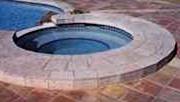Cantera Natural Stone Pavers - Introduction
Welcome to our Cantera Pavers Section!
IntroductionThe profession of quarrying and working with Cantera Stone in Mexico has developed over the centuries from a coming together of European and Mexican cultures. The word ‘Cantera’ is derived from the Spanish language, which means quarrying stone. Cantera Stone is a natural stone mined and quarried in the central and southern parts of Mexico. |
 |
Composition
Cantera stone is a volcanic quartz-based stone. It was formed millions of years ago, by extreme volcanic heat and pressure as a result of the mixing of lava flow and the softer rocks derived from the solidification of other materials present in volcanic eruptions, being ash flows and ash tuffs.
Cantera Stone is Ideal for Hotter Climates and Swimming Pools
The interesting and unique thing about cantera stone is it has a porous texture Its porosity and molecular structure allow it to breathe by absorbing air and humidity, without causing the stone to expand or contract in varying weather conditions. This means it’s ideally suited for hotter climates and swimming pool pavements because the cantera pavers will remain cooler than other paver materials, especially poured-in-place concrete pavements.
ApplicationsCantera stone is naturally strong and durable, yet light weight, making it an ideal material for a wide variety of architectural and building applications such as pavers, entryways, fireplace surrounds, columns, fountains, balustrade, sculptures, window trims and crown moldings and more. |
 |
Aesthetics
The natural appearance of cantera stone pavers is characterized by corkboard type grains, with an assortment of volcanic particles. Other cantera pavers have clean, uniform veining that blend evenly. Cantera pavers are available in an exciting and wide variety of colors, shades, densities, and sizes. Overall, they look inviting, as they show up fresh in summer and warm in winter. |
 |
Grading
There are two grades of cantera stone. Grade one is regular cantera and the grade two is called Adoquin. The differences between them are that Adoquin has a greater density, greater strength and is less malleable than regular Cantera Stone. The cost of the Adoquin is generally higher compared to regular Cantera because Adoquin is denser, more difficult to shape and form resulting in higher labor cost. The choice of cantera stone pavers grade is really a matter of individual preference as both grade are suitable for pavement and landscaping projects.





